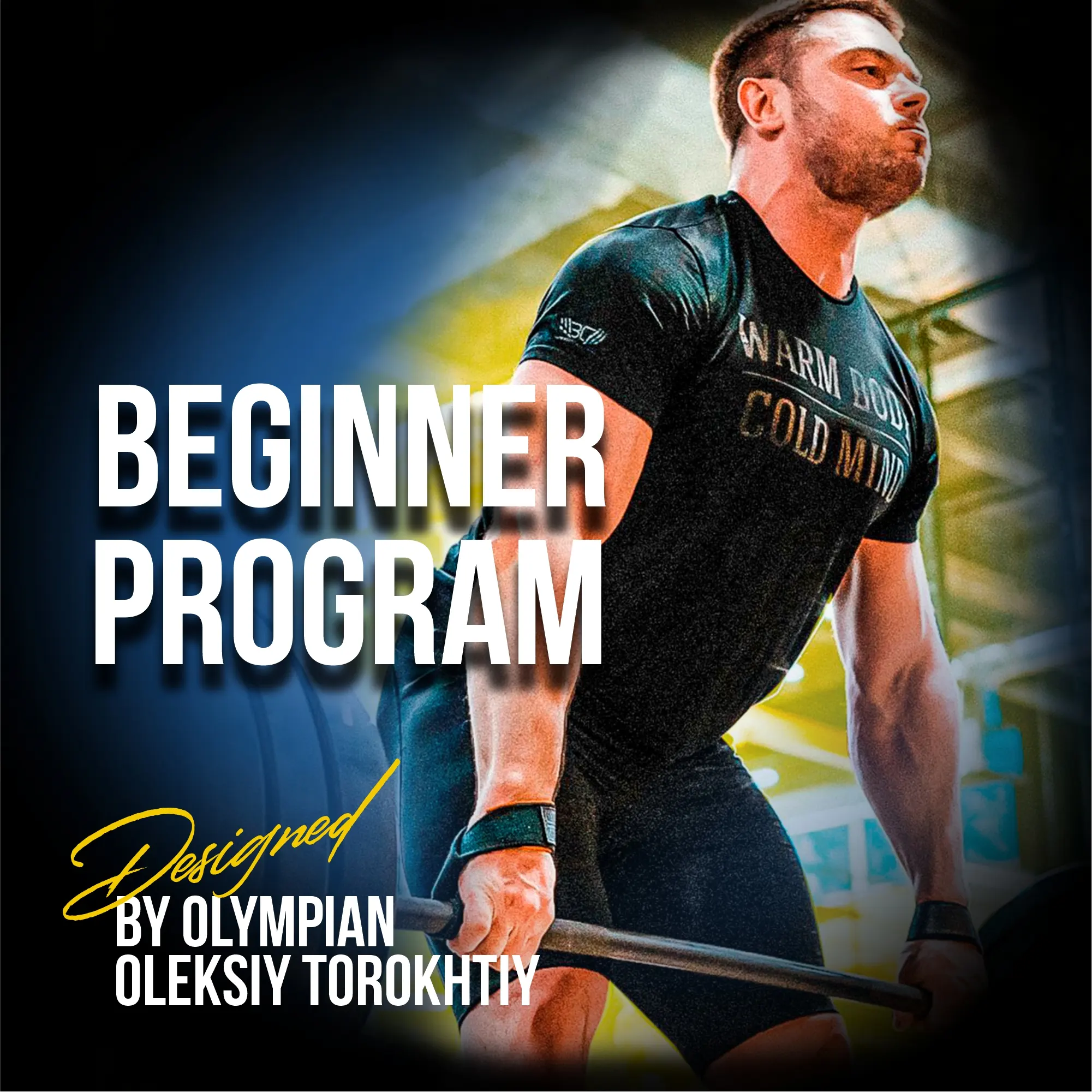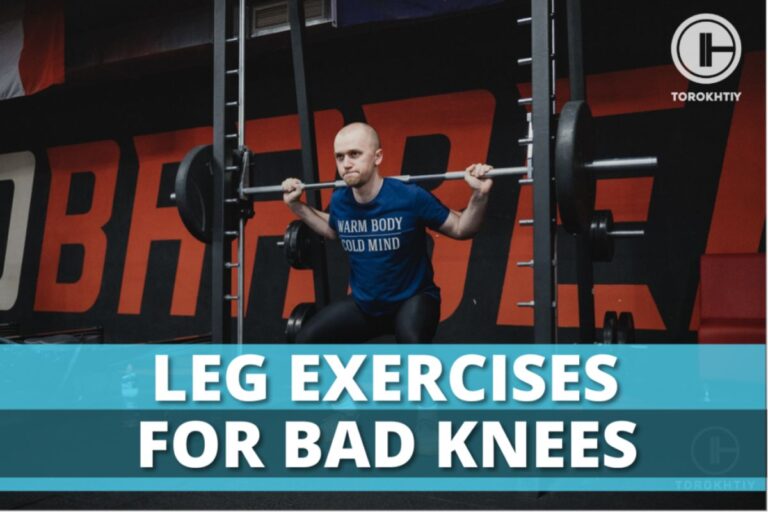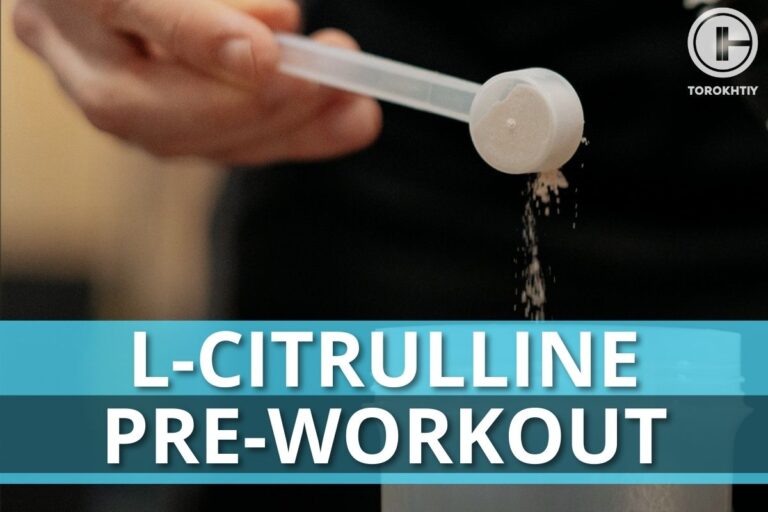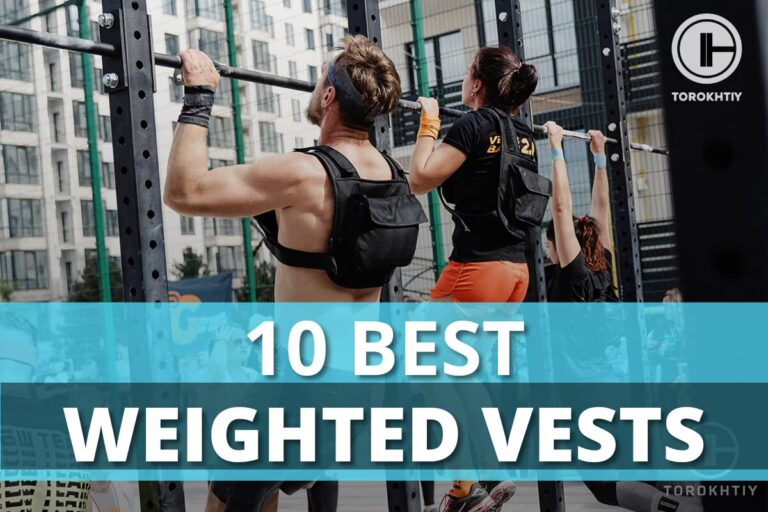Detailed Olympic Weightlifting Program For Beginners
Reviewed by: Oleksiy Torokhtiy (21 years of Oly Lifting experience)
What is Olympic weightlifting? Olympic weightlifting it is a kind of sport in which athletes must lift a bar as heavy as they can. Snatch with Clean & Jerk are the two competitive exercises. Winners are chosen for the highest total in kilos both exercises or sometimes in one of them.
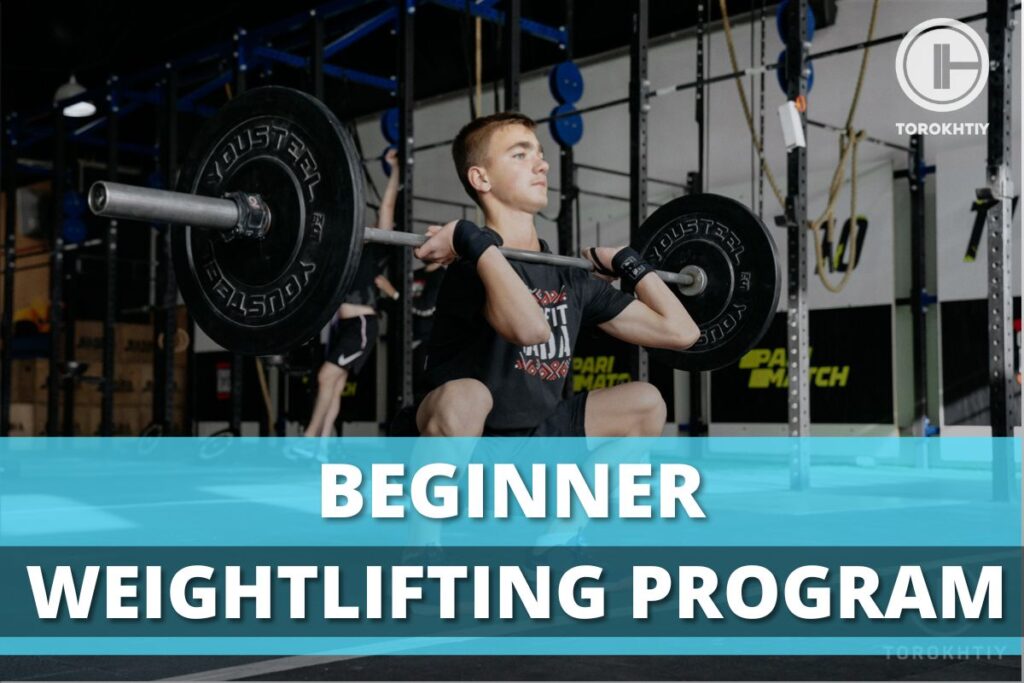
Men participate in ten weight classes: 55 kg, 61 kg, 67 kg, 73 kg, 81 kg, 89kg, 96 kg, 102 kg,109 kg and above 109
Women’s weight classes are as follows: 45 kg, 49 kg, 55 kg, 59 kg, 64 kg, 71 kg, 76 kg, 81 kg, 87 and + 87 kg
Every athlete uses the same equipment to compete.
The barbell is – 220 cm long for males and 201 cm for women. Its diameter is 28 & 25 mm.
A complete set of 45 cm diameter colored standard rubberized discs is used for competitions: green – 10 kilos, yellow – 15 kilos, blue – 20 kilos, red – 25 kilos.
Smaller discs can also be utilized to gradually increase the bar weight. These discs’ color designations are: green – 1 kg, yellow – 1.5 kg, blue – 2 kg, red – 2.5 kg, and white – 0.5 & 5 kg.
For the purpose of securing the discs on the bar, there must be 2 collars, each is 2.5 kg.
A 4 by 4 meters platform is used for competition. The borders of the platform are occasionally painted with a bright color since they should not blend into the floor. Such a line has a minimum length of 15 cm.
The platform is built of wood, plastic, or any other hard substance. The sole criterion is – it not be slick. Platform height may be between five and fifteen cm.
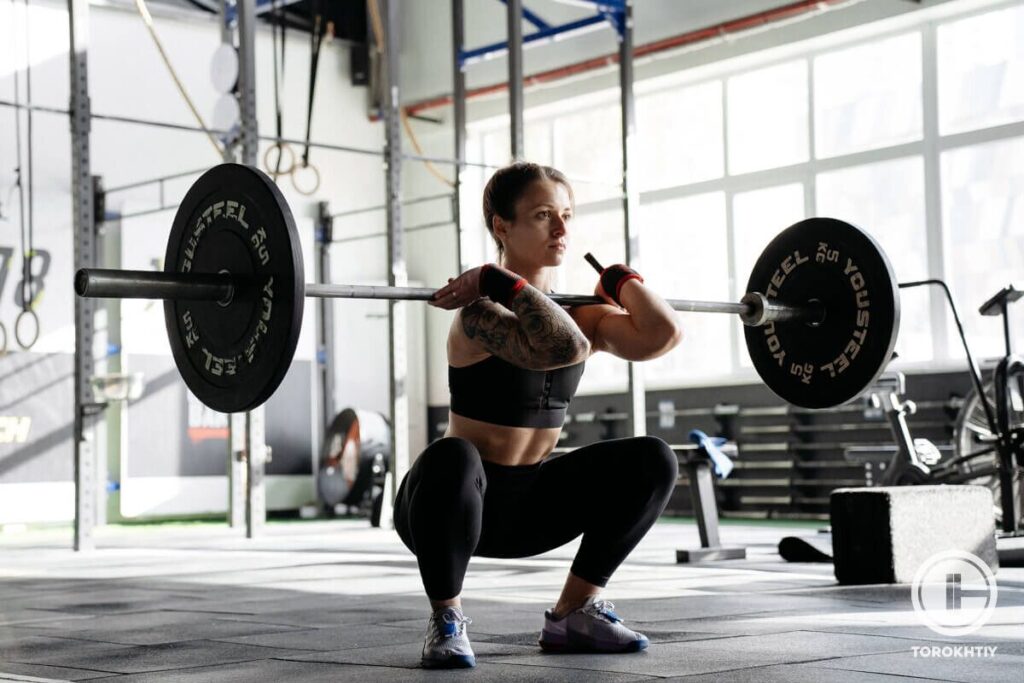
Benefits Of Olympic Weightlifting
When it comes to fitness and strength training there are countless options to choose form. From Functional Fitness to powerlifting, yoga or bodybuilding, it’s easy to get overwhelmed by this variety of exercises and techniques available.
However, one sport has gained popularity among fitness enthusiasts, athletes and beginners alike is Olympic weightlifting. Despite its name, Olympic weightlifting isn’t just for elite athletes or Olympians – it can be a fantastic choice for beginners as well.
Let’s find out the benefits of Olympic weightlifting
✅ Total Body Training
Olympic weightlifting is a full-body workout like no other. It primarily focuses on two lifts: Snatch and Clean and Jerk. This lift requires the use of almost every muscle group in your body. From your legs and back to your shoulders and core, you’ll develop strength and power in a balanced and comprehensive way.
Unlike some other strength training methods that are light specific muscle groups, Olympic weightlifting ensures that all parts of your body work together, promoting functional strength that can be applied to everyday activities.
✅ Improved Athletic Performance
Whether you are an athlete looking to enhance your performance in a particular sport or a fitness enthusiast aiming to boost your overall athleticism, Olympic weightlifting can be a game-changer. The explosive nature of the lifts helps improve speed, agility and power.
The ability to generate force quickly is essential in many sports and Olympic weightlifting can help to develop this attribute. Additionally, Olympic lifts can enhance your coordination and balance, making you more agile and proficient in various physical activities.
🔻Olympic Weightlifting Program For Beginners
🏋️ Get Started Right with Our Beginner’s Program!
Are you new to weightlifting and looking for the perfect program to kickstart your journey? Look no further! Join Olympian, World, and European Champion Oleksiy Torokhtiy 🇺🇦 in the Beginner’s program.
Key Benefits:
- 💪 Build Strength and Technique
- 🏅 Expert Coaching by Olympian Alex Torokhtiy
- 🏋️ Focus on Snatch and Clean & Jerk
- ⏰ 3 Weekly Sessions (50-80 mins each)
- 📽 Clear Video Instructions
- 💯 100% Money-Back Guarantee
- 🔥 Break Personal Records
- 🤝 Perfect for Beginners
Say goodbye to the common struggles that beginner weightlifters face and embrace the guidance and expertise of an Olympic champion.
✅ Efficient Time Investment
For beginners who lead busy lives finding time for work out can be challenging. Olympic weightlifting offers a time-efficient solution.
Since it involves compound movements that target multiple muscle groups simultaneously, you can achieve significant results with shorter training sessions compared to traditional bodybuilding style workouts.
Spending less time at the gym while still reaping the rewards is a win-win situation for beginners with tight schedules.
✅ Mental Toughness and Focus
Olympic weightlifting isn’t just a physical challenge, it’s a mental one as well. Beginners quickly learn the importance of concentration, focus and mental toughness, when attempting to lift weights with proper technique.
This mental fortitude can translate into other aspects of life, helping individuals become more resilient and disciplined in the face of challenges.
✅ Injury Prevention And Mobility
While Olympic weightlifting may seem daunting at first, it emphasizes proper technique and mobility. As a result, beginners are encouraged to work on their flexibility and range of motion which can help prevent injuries.
Learning to lift with correct form not only minimizes the risk of injury, but also promotes long-term joint and muscle health. Many beginners find that Olympic weightlifting helps them become more in tune with their bodies and more conscious of their movement patterns.
✅ Community and Support
One of the often-overlooked benefits of Olympic weightlifting is the sense of community that comes with it. Many gyms and weightlifting clubs offer a supportive and encouraging environment for lifters of all levels.
Beginners can learn from experienced athletes and receive guidance from coaches who are passionate about the sport. This camaraderie can be motivating and make the journey into Olympic weightlifting more enjoyable.
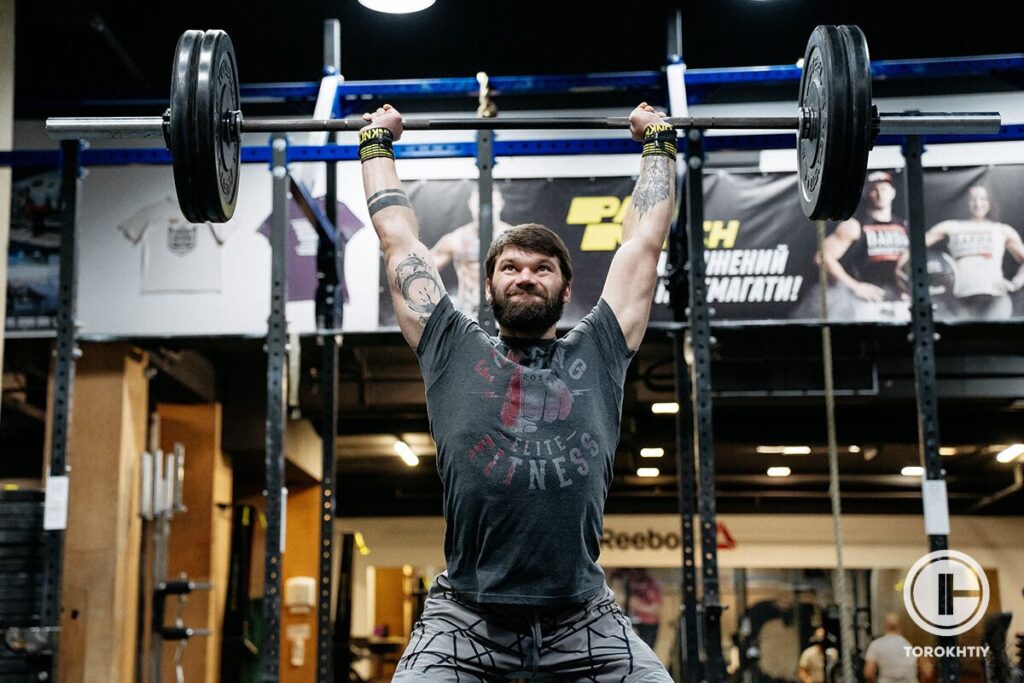
✅ Measurable Progress
Beginners often find motivation in seeing progress. Olympic weightlifting provides a clear measure of improvement in the weight of the bar. As you gradually increase the weight you can lift in snatch and clean and jerk.
You’ll experience a sense of accomplishment then can be incredibly motivating. This progress can help beginners stay committed to their training and goals.
✅ Versatility and Adaptability
Olympic weightlifting can be adapted to suit various fitness goals. Whether you are looking to build muscle, increase strength, lose weight or enhance athletic performance, the principles of weightlifting can be customized to your needs.
This versatility makes it an ideal choice for beginners who may not be sure of their specific fitness goals yet.
✅ Confidence Boost
As you progress in Olympic weightlifting you gain confidence not only in your physical abilities, but also in yourself. Overcoming the challenges of lifting heavy weights, mastering intricate techniques can boost self-esteem and self-belief.
This newfound confidence often spills over into other aspects of life. helping beginners tackle challenges with a positive mindset.
✅ Fun and Excitement
Last but not least, Olympic weightlifting can be incredibly fun and exciting. The thrill of successfully lifting a heavy weight or achieving a personal goal can be addictive.
Many beginners find the sense of accomplishment and excitement they experience during weightlifting sessions keeps them motivated and engaged in their fitness journey.
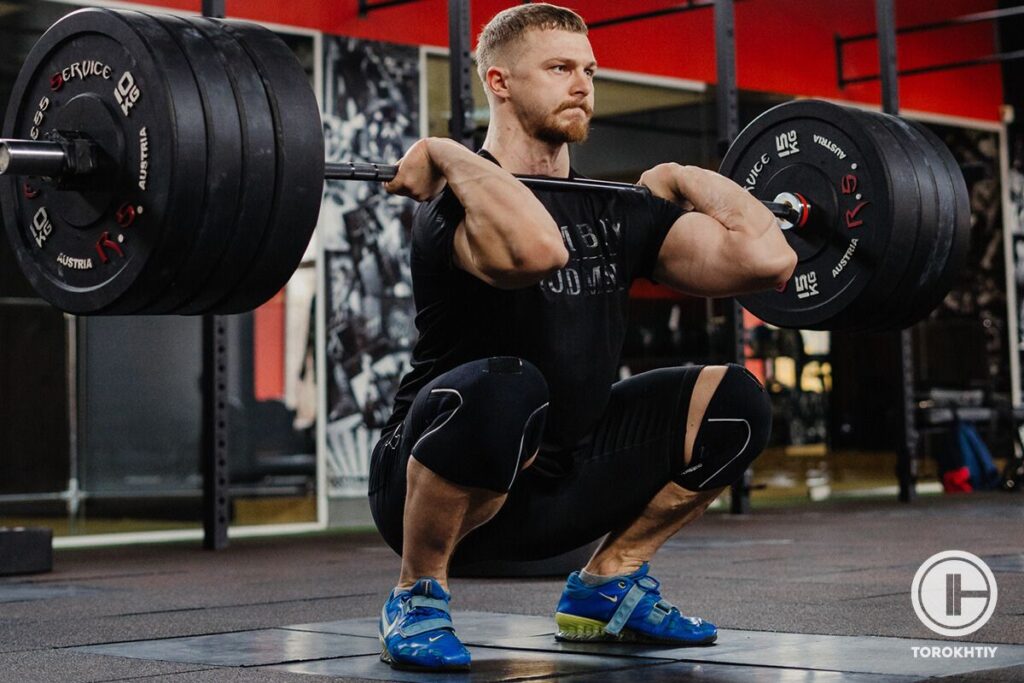
Main Olympic Lifting Movements
Let’s now discuss the drills used in olympic weightlifting program for beginners.
1. Snatches
In a snatch, the lifter must lift the bar in an overhead position in a single motion. In order to accomplish this, he must first sit beneath the bar, then raise it above his head while maintaining a straight posture. The legs may also be bent or in a lunge at the same moment.
There are many different snatch types employed in the beginner weightlifting plan, allowing to practice specific movement phases or intentionally increase speed or power.
Some of drills are listed below:
The major characteristic of the POWER SNATCH is – the lifter attempts to secure the barbell in the tallest position possible. By using this lifting approach, you may increase both the speed and amplitude of your movements.
When doing a HANG SNATCH, the weightlifter stands in the specific starting position with the bar below or above the knee level. You may load your back muscles way more and develop your power position and turnover.
Similar to a snatch, with the athlete standing on the mini platform, is the DEFICIT SNATCH. These movements are designed to develop balance, posture, and pull quality and to strengthen the legs. This exercise may also be employed for variety’s purposes and to boost the snatch’s strength.
2. Cleans
There are two parts in the Olympic Clean & Jerk. Lifting the bar to the front rack position is the first step for the weightlifter. The next step is to drive the barbell upward while keeping your arms straight.
Let’s start by looking at CLEAN. Weightlifters use the clean as a training drill to enhance lifting-related skills. It may be utilized to improve power, speed-strength, mobility and accuracy for other sports.
A lot of clean modifications are employed during the training process, allowing to improve certain movement phases or intentionally increase strength or speed.
Some of drills are listed below:
The major characteristic of the POWER CLEAN is – the lifter attempts to catch the bar in the tallest position possible. You may increase the elbows’ ROM, explosive skill, and speed using this technique.
The CLEAN from BLOCKS can be used for a variety of purposes. The exercise Block Clean is done the same way as the regular Clean, with the exception that the barbell is placed on the special blocks. The most typical height of the blocks is at or below knee level.
Due to short acceleration distance and the fact that the action begins at a complete stop, this exercise will drive the weightlifter to accelerate the bar quicker.
CLEAN COMPLEX. Training the Clean together with some other strength drills in the one complex might make sense because the competitive workout C&J demands a high degree of athlete strength endurance. For instance, clean + clean pull or front squat are excellent ways to increase an athlete’s strength and endurance.
3. Jerks
The second stage of the C&J exercise is Jerk. The competition regulations allow a variety of Jerk styles.
SPLIT JERK: The athlete extends his feet in a backward-forward stance, performing an athletic specific lunge, after pushing the weight up.
In PUSH (POWER) JERK, after driving the barbell up, the lifter does instantly putting their feet a bit to the sides.
A beginner weightlifting routine consists of a significant variety of movements to enhance JERK. Take a look at a few of these activities:
BEHIND THE NECK JERK. This exercise is identical to the typical jerk from the rack, but the beginning position is with the barbell behind the head on the shoulders. You may improve your perception of the COG and practice the dip and drive phase with this exercise.
PUSH PRESS is the accessory exercise widely used in olympic lifting programs for beginners. The goal of the current drill is to push the weight firmly with your arms at the top while simultaneously engaging the drive of your legs.
JERK COMPLEXES. Considering that the Clean & Jerk demands a high degree of specific lifter`s endurance. Combining the Jerk exercise with other power and strength exercises together may be a logical choice.
For instance, front squat plus jerk and push press plus jerk are excellent exercises for increasing an athlete’s “power endurance” and strength.
4. Squats
SQUATS are the primary strength-training exercise used by weightlifters to build back & leg muscles. The most typical options are: Back Squat (paused, wide or narrow stance, on the bench), Front Squat, Split Squat.
Any beginner olympic lifting program must include a squat exercise since they assist in increasing power and strength, which are connected to hip and knee extension in almost all sports.
Depending on the objectives of training, coaches and athletes can set the athlete a variety of targets. The quadriceps, glutes, hamstrings, core, and posterior chain of body are all targets of the back squat training regimen.
Back Squat With Pause
Pause squats serve a variety of purposes. This exercise primarily and totally develops maximum strength since there isn’t a stretch-contraction response throughout the movement, which we use in traditional squats to go over the “dead spot.”
Additionally, it improves squatting mechanics, strengthens the core, and encourages mobility, which helps to control the bottom part of the squat. It is recommended a 3-second break in the bottom position.
Squat With Narrow Stance
These squats should be performed with feet that are closer together than hips and shoulders. The feet and knees are pointing in the same direction.
The principal muscles this movement targets are the quads, glutes & adductors. Because narrow stance squats are performed with less amplitude, the hips are less widely spread and the major mobility and pressure demands are focused on the ankle joint.
Such squats should be performed as deeply as is safe while preserving spine neutrality and maximum comfort. One of the main benefits of narrow stance squats is that, after three to four weeks, the majority of athletes see an increase in their ROM.
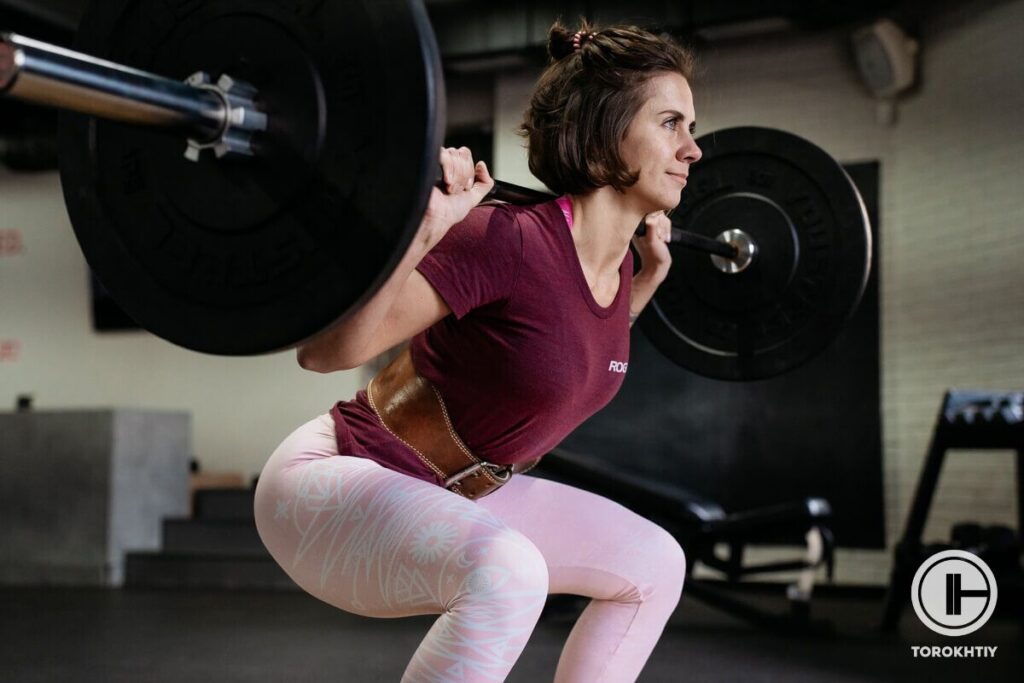
Front Squats
The barbell is held on the front rack/shoulder region. Due to the location of the bar, this squat variation targets the quadriceps more, making it a great alternative to the back squat for building core, leg strength & hypertrophy.
Split Squat
It is a great drill for exercising legs more specifically. This is great for any lifter, but when you have a leg that is dominant, it’s very helpful. As well as being executed with the front or rear foot elevated.
Split squats can also be performed while carrying dumbbells/kettlebells or a bar on the shoulders. You might target the quads more efficiently than your glutes by maintaining a more upright posture. However, a split squat in the bulgarian variation will help you train your glutes as well.
5. Pulls
Although most powerlifters refer to this type of exercise as deadlifts, in Olympic weightlifting more often refer to them as PULLS. The two that are most crucial are Clean & Snatch Pulls.
Let’s say – targeted movements for building strength and enhancing clean & snatch technique. These exercises come in a huge diversity, including:
- combo type pull with various grips;
- hang position pull;
- block position pull;
- deficit position pull;
Goals Of An Olympic Weightlifting Program
General Health
Developing a foundational wellness level is essential for long-term growth and injury avoidance. A variety of weight lifting regimes, including power, general strength, and other specific exercises, are necessary for the athlete’s health.
Flexibility
Even while a lot of beginners lack basic flexibility in certain positions, the most of them may increase their mobility just by performing the drills and progressively increasing their overall flexibility.
Coordination & Tech
Most weightlifters are continually striving to lift more and more weight. Technical pattern development is a top focus. Injury may be caused by strength alone and is a quick and easy path to it.
Muscles’ Hypertrophy
During a lifter’s sports career, quality muscles must be developed in order to become stronger and more powerful. Without the proper development of muscle hypertrophy, most lifters just would never develop their performance and strength.
Adaptation Of The Neural System
Weightlifting is a very neural demanding kind of sport where beginning athletes must learn to execute actions requiring a high degree of muscle control while moving heavy loads quickly.
Because a weightlifter must act quickly, powerfully, and incredibly precisely, their brain impulses & connections must be improved throughout the period of their career.
Development of Performance
Performance is the ability of the lifter to exercise actively without losing work efficiency or getting unduly fatigued.
Performance may be improved by progressively increasing the volume of the training, reducing rest periods, and including auxiliary and conditioning workouts. This is necessary for growth and the ability to accomplish more work.
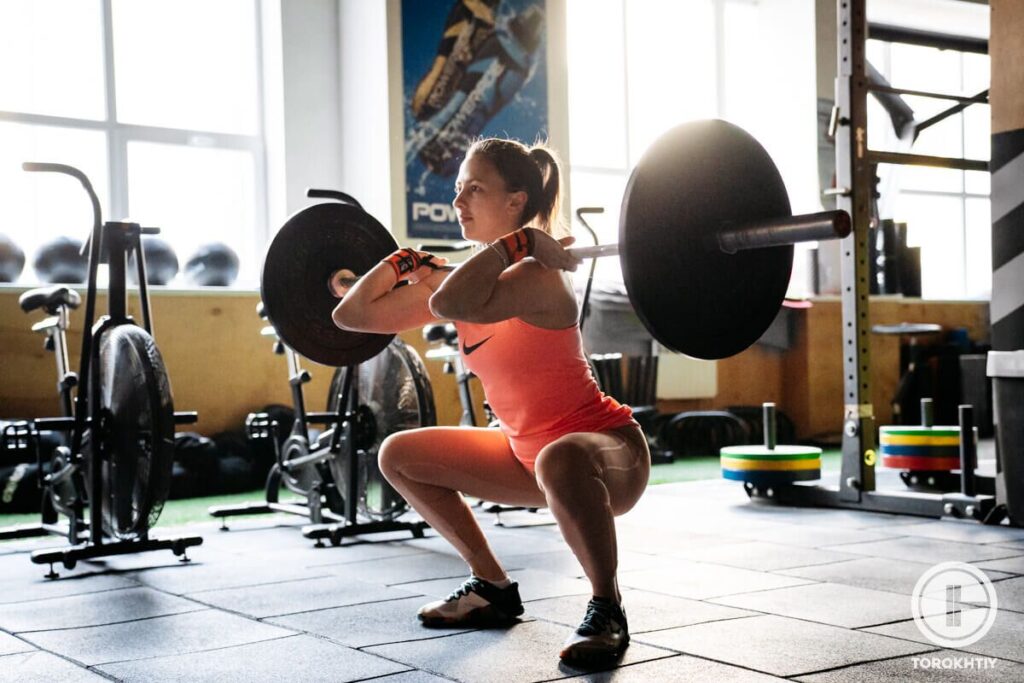
Programming for Advanced vs Beginners Lifters
It’s crucial to take into account how load programming differs for novice, intermediate, and elite weightlifters. There are many beginner weightlifting workout plans available, but you must remember that the loads must match your experience level.
Training Peculiarities for Beginners
Beginner athletes might range in experience from two months to six to twelve months. Their methodology is to learn the fundamentals of main movements, develop the major muscle groups, and mitigate their lack of technical proficiency.
In theory, an athlete can stay in the beginning division his whole life without feeling any problems. Beginners don’t require complex training plans, and frequently they lack even a defined and clear 1RM. Instead, they require regular repetitions of controlled weightlifting movements that let them concentrate on technique.
For strength exercises, they could adhere to a predetermined set and rep pattern (3×5), improving steadily from session to session.
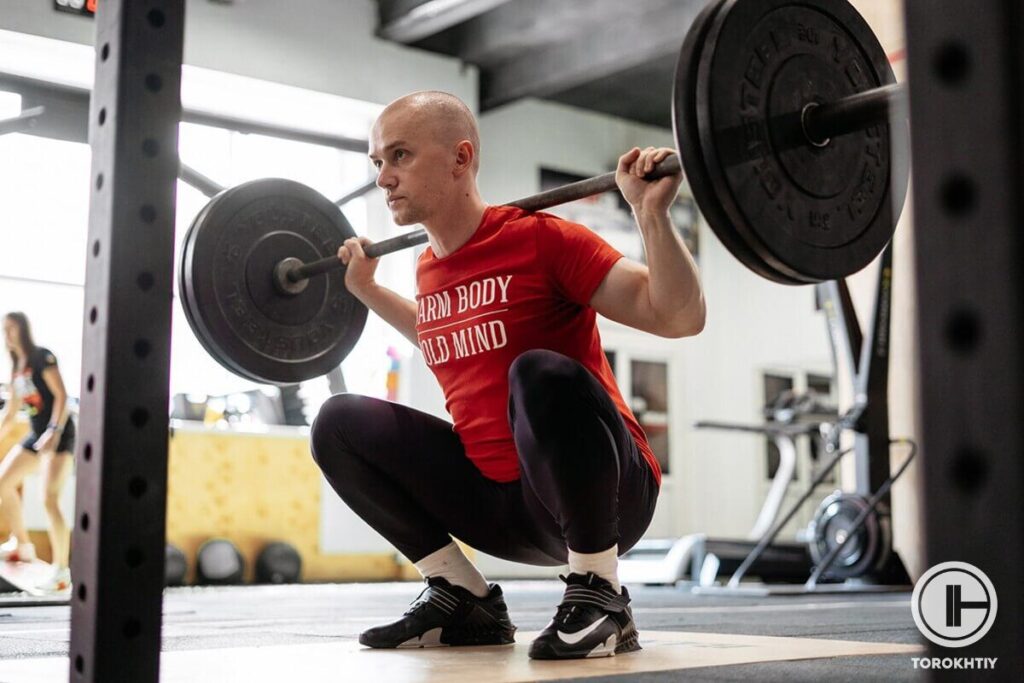
Training Peculiarities For Intermediate Lifters
Although they require more intensity and volume than beginners and have a consistent 1RM, intermediate weightlifters are still far distant from being elite & pro. A greater variety of weightlifting drills are used by intermediate lifters to eliminate technical faults and enhance movement quality.
Additionally, strength exercises like pulls and squats can make use of a wider range of sets & reps, which will result in a more dynamic growth of the results.
Training Peculiarities For Advanced Lifters
An increase in the quantity, volume, and intensity of training sessions is the major component of programming for advanced athletes. The 1 RM and the lifting technique used determine how well weightlifters at this level are trained.
A weightlifter with extensive athletic expertise trains differently from a novice since they utilize fewer exercises, but they also notice a big intensity and volume of training loads. Near-maximal weight training is more efficient, but it can also lead to overstrain, which can lead to injuries or other negative impacts for the athlete.
Key Factors in Beginner Weightlifting Routine
The science of creating a weightlifting program is complex. As a result, we won’t cover the entirety of the university lecture about programming here. These 5 fundamental guidelines will help you gain a general grasp of beginner lifting schedule.
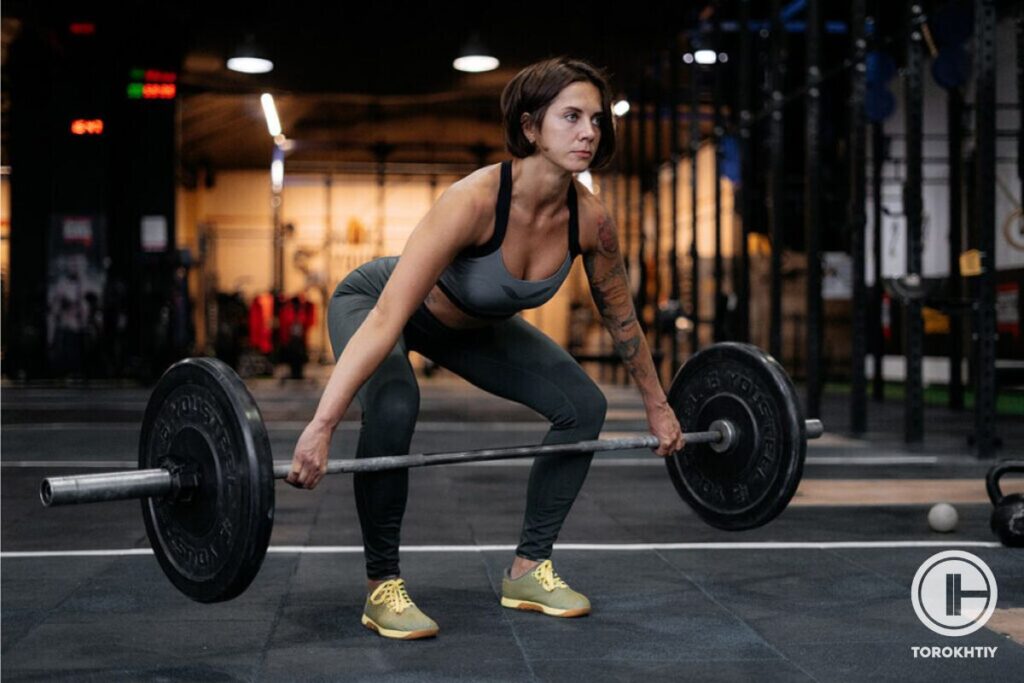
Snatch and C&J Workouts Serve as the Foundation for the Loads
For best results, weightlifting exercises should be performed three times a week or more frequently.
This is due to two factors:
- according to study, you should routinely work on improving your motor abilities.
- in order to observe the required adaptation in both snatch and C&J, you must develop a certain speed strength.
The Consistency of Fundamental Strength Training
Weightlifting is an Olympic strength sport, thus you must continually work to increase squat, pull, and overhead strength. There is only one weekly strength programming rule for weightlifters: 2 squats, 2 overhead movements, and 1 pull.
The best approach to perform squats is to perform back squats in one session and then front squats in another. Practice has taught us that this has the greatest impact on C&J progress.
Drills above the head should be alternated: one workout should just use JERKs, while the other should include military or push presses. As a result, there will be an optimal balance between static and dynamic stress on thу upper body.
Regarding the weight in the pulls, they should be used to develop the clean and snatch technique in addition to gaining strength. As a result, different pull types must be chosen based on the power & technical training demands.
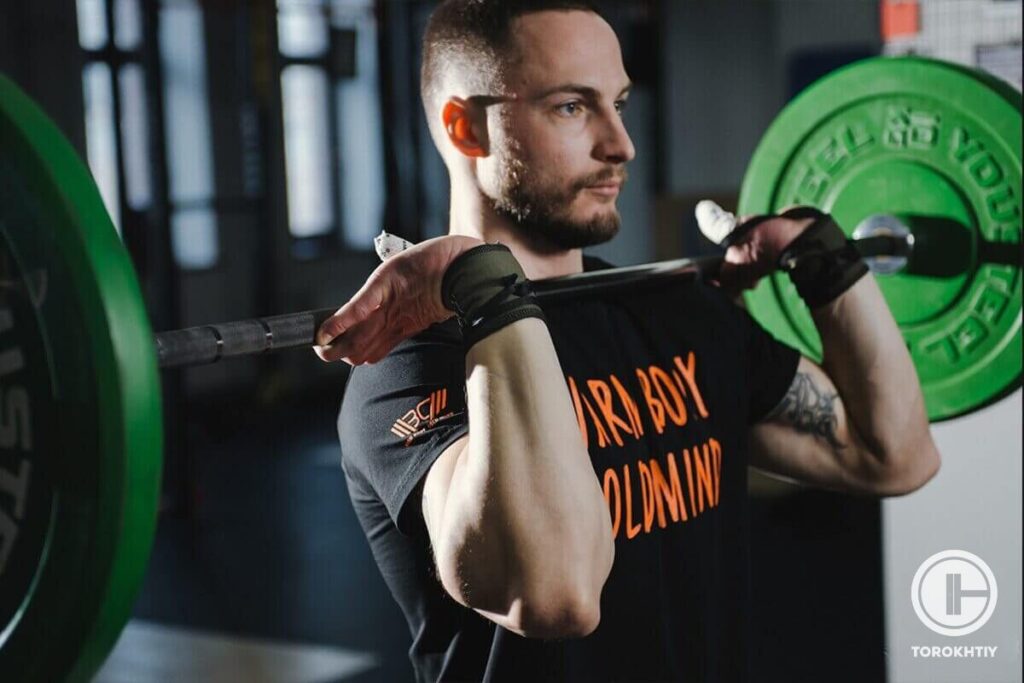
Smart Workload Schedule To Allow For Recovery Time
Now that you know, the beginner olympic weightlifting program pdf should include a variety of power, strength and auxiliary workouts. Let’s use the configuration on the five-day plan as an example to illustrate how to prevent overtraining:
- Monday – Heavy load
- Tuesday – Light load
- Wednesday – Medium load
- Thursday – Heavy load
- Friday – Light/Medium load
You can perform big lifts, a high number of reps (over 3), or to combine these 3 parameters on heavy days. When it’s a medium or light day, then reduce these settings.
Load Distribution In The C&J And Snatch Exercises
Coaches employ four intensity zones for an effective utility of loads:
- up to or around 60% – in recovery or light exercises and in warm-up the load is completed around these weights, the ideal range is 3-6 reps in 4-6 sets;
- 70 to 80%; those workloads allow for the best tech practice and the best training effect is carried out here (the optimum range is 3 repetitions for 4-5 sets);
- The hardest work with modest volumes is between 80 and 90% (for example, 1-3 reps for 2-4 sets);
- Competitive & extreme and loads of 90% and higher (in one session recommended, from 2 and up to 6 singles).
Technical faults in competitive Snatch or C&J movements are more likely to occur when working weights are higher. Because of this, the main criterion for allocating the workload is to do the majority of the lifts with loads between 70 and 80-85 %, the average amount with loads between 85 and 90%.
The minimal number of reps with loads over 90%. An athlete’s training regimen gets more rigorous as his level increases. However, even exceptional athletes don’t get beyond 13% in workloads over 90% and more.
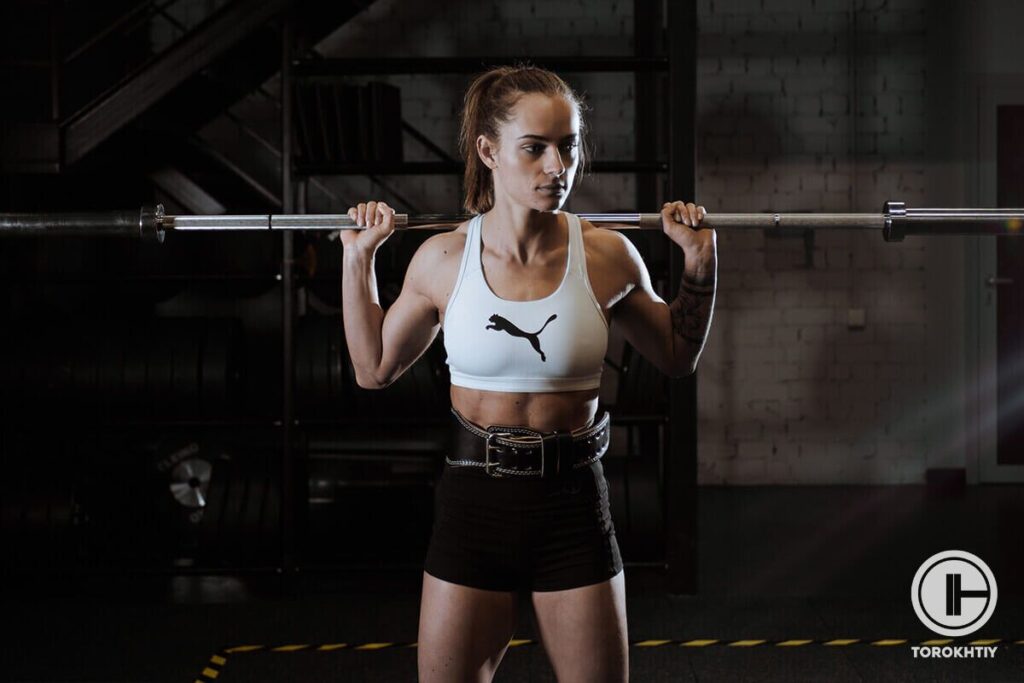
The Distribution of Load During Strength Training
When it comes to strength training, you shouldn’t overcomplicate things. Try to do three to five sets of three to five reps for the squats, pulls, and presses.
It is advised to perform the majority of the power training at the 8 level of RPE for individuals, who are good with RPE approach. This might range in percentage values from 75 and up to 90%. The majority of lifting programs use this kind of load as well.
Important Elements of a Weightlifting Routine
Weightlifting in the modern day is a challenging speed-strength coordination sport. The growth of speed and strength is given particular focus during the weightlifters’ training process. The growth of one physically influences the progress of the another, but not always; their link is the closest and most ambiguous.
This happens when the amount of maximal force needed to move against a powerful external resistance while moving quickly rises. Weightlifters must continuously increase their flexibility, movement coordination and agility in addition to their physical attributes.
These characteristics have a direct impact on how well competitive activities go. The features of the muscular contraction, the weight, the volume of load, as well as other factors all affect the load.
However, intensity & volume are essentially the two components that influence the load in olympic weightlifting for beginners and advanced lifters.
Volume
An athlete’s degree of fitness steadily rises and they start to take on a performance shape with an increase in preparation of a characteristic like volume. And the longer the lifter maintains his athletic shape, so the more training is done.
Volume may be defined as the quantity of work completed. It is frequently taken into account when calculating the repetitions per set, session, week, mesocycle, and year.

Intensity
The load intensity is another feature. In simple words – it is a quality of training work. The methods for increasing the load’s intensity are relatively varied, but they all essentially come to the same things: gradually increasing the barbell’s weight, the number of reps used in the set, the working time, increasing the pace, etc.
Program Variability
Increases in load volume should be progressive and varied in nature, taking the shape of waves, different levels or steps and so on. This considers the athlete’s age as well as his degree of technical, mental, physical, and theoretical readiness.
Variability enables a shift in the workload over a wide timeframe (mesocycle and beyond), and a smaller time frame (microcycles) and within a single training session as well. Variability also defines diverse combinations of means in addition to varied alternatives for constructing a load.
Even if elite lifters have a small number of them, they should be extremely diverse. Unfortunately, in the free OLY lifting programs that you may discover online, this feature is frequently overlooked.
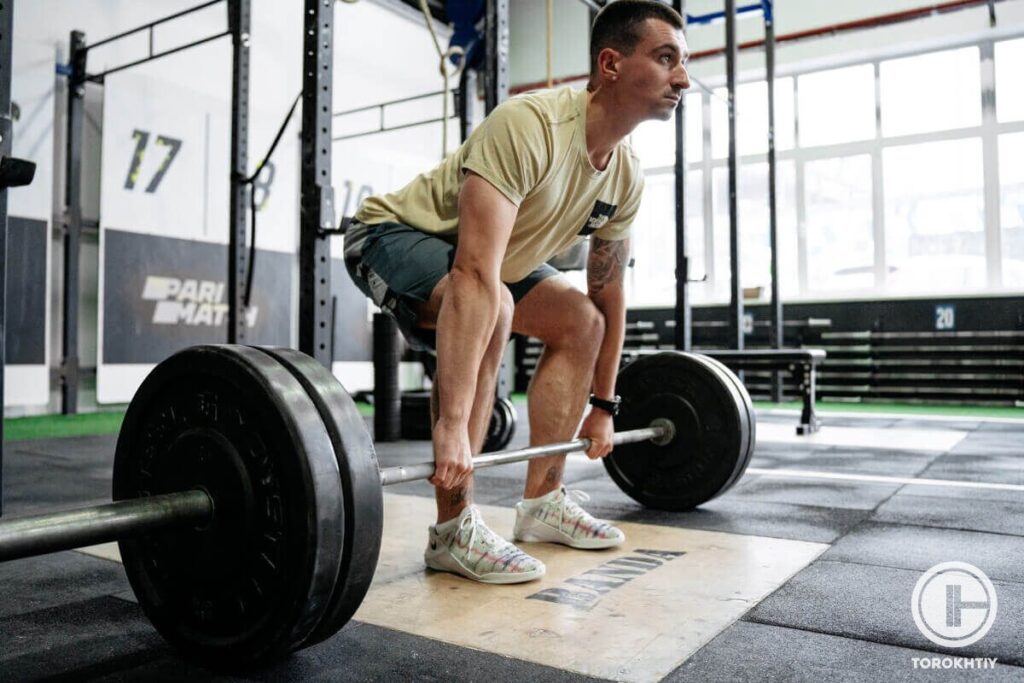
Olympic Lifting Program for Beginners
As far as main goals of beginners training in Olympic weightlifting are:
- learning proper technique;
- building solid foundation;
- progressive overload;
- developing speed and explosiveness;
- enhancing mobility and flexibility:
the basic training week template can consists of 3 days and look like that:
Session 1
- Specific Warm-up (2-3 rounds)
- SUPERMAN (15 reps)
- ABS (20 reps)
- Muscle SNATCH (3 sets / 6 reps)
- Power SNATCH (4 sets / 3 reps)
- Snatch DEADLIFT (3 sets / 5 reps)
- Back SQUAT (4 sets / 4 reps)
- Accessory load
- Rear Delt FLY (3 sets / 12 reps)
- Military PLANK (3 sets / 8 reps)
Session 2
- Specific Warm-up (2-3 rounds)
- HYPEREXTENSION (10 reps)
- Gakk SQUAT (8 reps)
- THRUSTER (3 sets / 6 reps)
- Power CLEAN (3 sets / 3 reps)
- Good Morning (3 sets / 8 reps)
- Split SQUAT (3 sets / 6+6 reps)
- Accessory load
- Squat JUMPS (3 sets / 8 reps)
- Lat PULL (3 sets / 12 reps)
Session 3
- Specific Warm-up (2-3 rounds)
- SUPERMAN (15 reps)
- ABS (20 reps)
- Muscle Squat SNATCH + Overhead SQUAT (3 sets / 4+4 reps)
- Front SQUAT + JERK (3 sets / 3+3 reps)
- Front SQUAT (4 sets / 4 reps)
- Bench PRESS (4 sets / 8 reps)
- Accessory load
- PUSH UP (3 sets / 15 reps)
- French PRESS (3 sets / 15 reps)
There is no exact load percentage, because the most important goal for this period of training is to pick up the weight which will be affordable to maintain proper form, but at the same time challenging enough to load muscles.
The beginners Olympic weightlifting program prioritizes the development of proper technique, strength, speed and mobility. By incorporating a variety of lifts, accessory exercises and specific warm-ups it offers a comprehensive approach to training.
Consistency and dedication will help beginners lay a solid foundation and progress steadily on their journey towards mastering the Art of Olympic weightlifting.
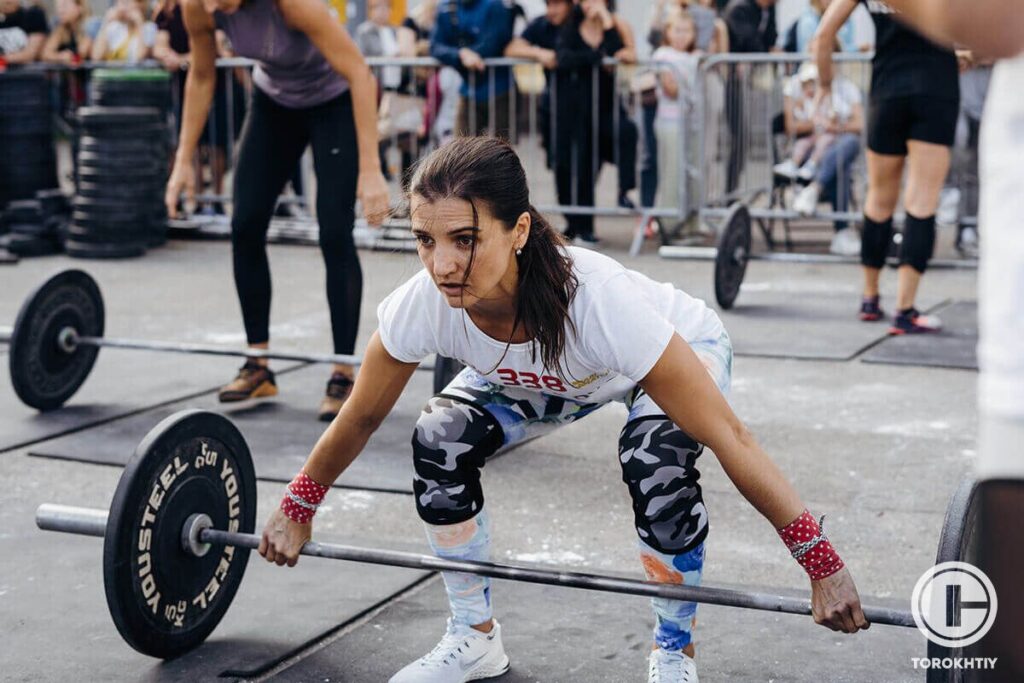
Common Beginner Weightlifting Programming Mistakes
Inadequate Foundation Strength Work
It’s common for beginners and even trainers to overlook the reality that Olympic weightlifting is a sport of power. Athletes who are unable to deadlift 100 kg will most certainly be unable to clean that weight.
The leg & back strength and overall performance required to carry out heavy kilos will not be increased by performing just two sets of three reps of squats at 70–80% of your best squat clean.
An Improper Ratio of Strength to Dynamic Exercises
The opposite side likewise has a twist. Some free OLY lifting programs place an excessive emphasis on building strength and not enough effort on Olympic Snatch and C&J exercises.
Athletes who can easily back squat over 440 lb (200 kg) or even deadlift 500 lb, but still struggle to snatch 220 lb (100 kg) often look like this. Remember that no quantity of strength training will be able to enhance the mechanics and skill of Olympic lifts for beginners.
Additionally, you should be aware that the ratio of strength to dynamic (Snatch and Clean and Jerk) movements in the entire volume has a gold standard. The volume should aim for the specific ratio for appropriate improvement in Olympic weightlifting in monthly and weekly cycles:
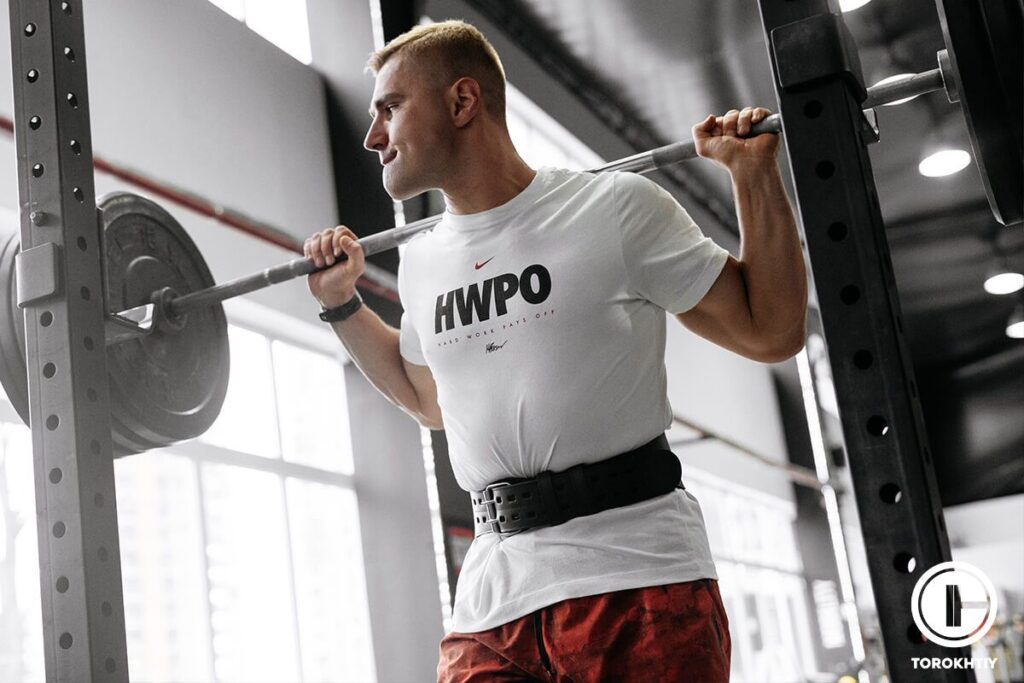
- Snatch drills – around 25%
- C&J drills – around 25%
- Pulls for Snatch – around 10-12%
- Pulls for Clean – around 10-12%
- Squats – around 25%
Naturally, variations of 4-6% are permitted. It will depend on the training time and the particular athlete.
Program Design Without Taking Recovery Into Account
Another frequent error is when a weightlifting program contains all the necessary components for building technical & strength skill, but is arranged in such a way that the lifter is perpetually exhausted, which ultimately results in overuse and injury. There are relaxing days and deload weeks for a purpose.
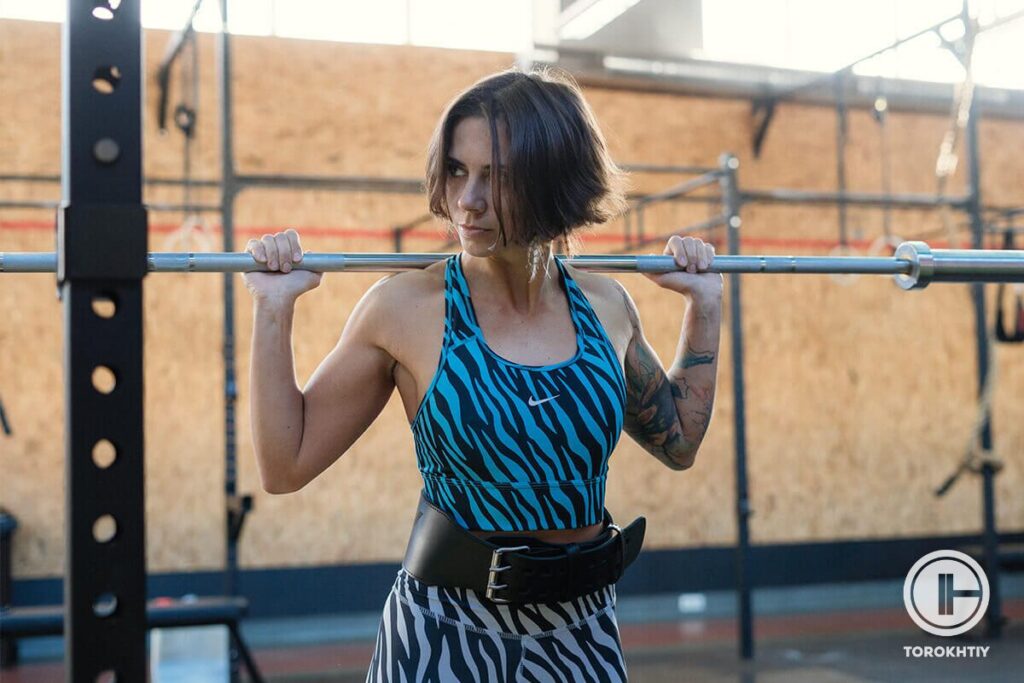
FAQ
How Frequently Should I Train?
This olympic weightlifting beginner program is designed to be 3 days per week. We do not recommend training 3 days in a row by a beginner weightlifting workout. On your rest days, try to plan recovery activities, such as massages, or sauna.
What Are Some Beginner Tips for Olympic Weightlifting?
- Start by learning the basic lifts – the snatch and the clean and jerk. These are the most technically challenging lifts and require a lot of practice to perfect.
- Practice frequently – Olympic weightlifting is a highly technical sport, so you need to practice regularly if you want to improve.
- Be patient – It takes time to master Olympic weightlifting, so don’t get discouraged if you don’t progress as quickly as you’d like. With practice and dedication, you’ll eventually reach your goals.
What Exercises Are Included in a Olympic Weightlifting Program for Beginners?
Beginner weightlifting plan usually involve exercises such as the snatch, the clean and jerk, front squats, back squats, power cleans, and push presses.
What Equipment Do I Need for the Beginner Weightlifting Routine?
- Barbell and Bumper Plates
- Squat Rack
- PVC
- GHD
- Shoulders activation system
- Lifting straps
- Rubber bands
- Blocks
- Kettlebells
- Plyometric Box
What Should I Expect in Terms of Results From a Beginner Weightlifting Workout?
Some of the benefits you can expect are increased strength, improved power, and better coordination. You might also see an increase in muscle mass, as well as a reduction in body fat.
However, it’s important to be aware that Olympic weightlifting is a challenging sport, and beginners should always start out slowly and progress gradually to avoid injuries.
What If I Have More Questions?
Leave us a comment in the section below the article!
Also Read:
- 3 Day Olympic Weightlifting Program
- 2 Day Olympic Weightlifting Program
- 4-Week Olympic Weightlifting Program
- 10 Week Olympic Weightlifting Program
- 8 Week Squat Program
- 12 Week Squat Program
- Women’s Olympic 12-Week Weightlifting Program
- Weightlifting Program for Women
- Olympic Lifting Training Program
References:
- Rafał Szafraniec, Janusz Bartkowski, Adam Kawczyński “Effects of Short-Term Core Stability Training on Dynamic Balance and Trunk Muscle Endurance in Novice Olympic Weightlifters” J Hum Kinet. 2020 Aug
- Helmi Chaabene, Olaf Prieske, Melanie Lesinski, Ingo Sandau, Urs Granacher “Short-Term Seasonal Development of Anthropometry, Body Composition, Physical Fitness, and Sport-Specific Performance in Young Olympic Weightlifters” Sports (Basel). 2019 Nov 30
- Achraf Ammar, Mouna Turki, Hamdi Chtourou, Omar Hammouda “Pomegranate Supplementation Accelerates Recovery of Muscle Damage and Soreness and Inflammatory Markers after a Weightlifting Training Session” PLoS One. 2016 Oct 20
- Achraf Ammar, Mouna Turki, Hamdi Chtourou, Omar Hammouda “Pomegranate Supplementation Accelerates Recovery of Muscle Damage and Soreness and Inflammatory Markers after a Weightlifting Training Session” PLoS One. 2016 Oct 20
- Marianne Huebner, David Meltzer, Wenjuan Ma, Holly Arrow “The Masters athlete in Olympic weightlifting: Training, lifestyle, health challenges, and gender differences” PLoS One. 2020 Dec 4.
Why Trust Us?
With over 20 years in Olympic Weightlifting, our team does its best to provide the audience with ultimate support and meet the needs and requirements of advanced athletes and professional lifters, as well as people who strive to open new opportunities and develop their physical capabilities with us.
By trusting the recommendations of our certified experts in coaching, nutrition, dietology, and sports training programming, as well as scientific consultants, and physiotherapists, we provide you with thorough, well-considered, and scientifically proven content. All the information given in the articles concerning workout programming, separate exercises, and athletic performance, in general, is based on verified data. We ensure that you can rely on our professionals’ pieces of advice and recommendations that can be treated as personalized ones which will benefit you and fully meet your needs.
The product testing process is described in more detail here
Author: Sergii Putsov
Head of Sport Science, PhD
Best Results: Snatch – 165 kg,
C&J – 200 kg
Sergii Putsov, Ph.D., is a former professional weightlifter and National team member, achieving multiple medals in the 94 kg weight category at national competitions. With a Master’s degree in “Olympic & Professional Sport Training” and a Sport Science Ph.D. from the International Olympic Academy, Greece, Sergii now leads as the Head of Sport Science. He specializes in designing training programs, writing insightful blog articles, providing live commentary at international weightlifting events, and conducting educational seminars worldwide alongside Olympic weightlifting expert Oleksiy Torokhtiy.
Reviewed by: Oleksiy Torokhtiy
Olympic Weightlifting Champion
Best Results: Snatch – 200 kg,
C&J – 240 kg
Oleksiy Torokhtiy is a professional athlete boasting 20 years of experience in Olympic weightlifting. With multiple European and World titles under his belt, he has showcased his prowess in two Olympic Games (Beijing 2008 and London 2012). Upon concluding his illustrious career, Oleksiy dedicated himself to coaching. By 2022, he had conducted over 200 weightlifting seminars worldwide. He is the visionary behind an international sportswear and accessories brand known for its motto, “Warm Body Cold Mind.” Additionally, he is an esteemed author and the creator of a series of training programs and eBooks.

